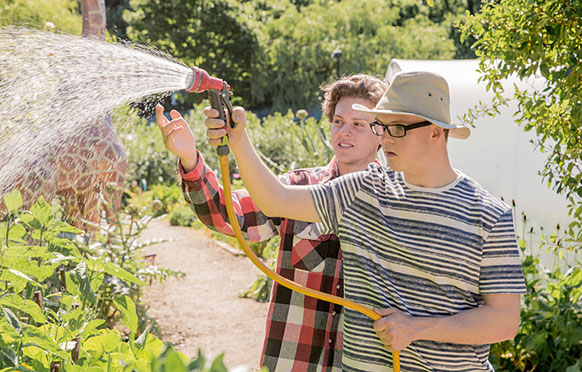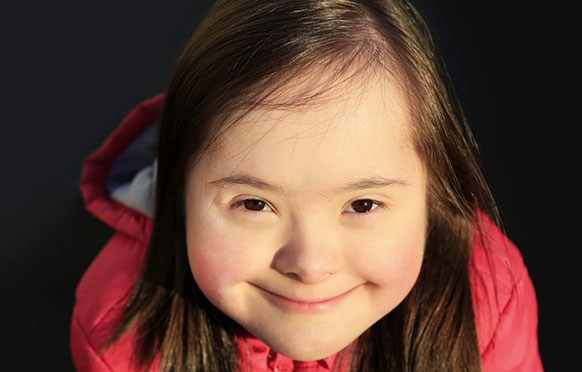
Fact Sheet FS1287
Introduction
There are three basic learning styles: Visual, Auditory, and Kinesthetic. Visual learners learn better by watching rather than listening and tend to better remember the details of information that they see. Auditory learners learn best by listening. They depend on hearing and speaking as their main way of learning. They may repeat back to themselves or others to sort through the information that is being conveyed. Kinesthetic learners learn best by using the hands-on approach, active movements, and through experience. They like to learn as they go and generally do not look at the instructions first. In addition, kinesthetic learners usually prefer group or team activities.
Like many people, individuals with developmental disabilities are visual learners and learn better with visual supports. When working with both adult and youth audiences, it is important to understand the visual learning style and how and why visual supports help individuals be more successful in the learning environment. Visual supports can be helpful in managing behavior and reducing anxiety as individuals transition between activities, schedules, or settings.
Visual Learners
People with developmental disabilities are most often strong visual learners. They understand what they see better than what they hear. Visual supports, also called visual cues, are tools that help learners in many ways. They enhance learning by helping visual learners understand activities, tasks, directions, and discussions. Visual supports facilitate attention-getting; make ideas and concepts more concrete; aid in recall of verbal information; serve as effective prompts; cue appropriate behavior; and ultimately facilitate independence. The usage of visual supports or cues can enhance learning and engagement thus reducing the potential for problematic behavior.
What Are Visual Supports?
Visual support refers to using a picture or other visual item to communicate with an individual who has difficulty understanding or using language.
Research has shown that visual supports or cues work well in communication. Visual supports provide information learners can see which enhances the communication process. Ranging from body movements to environmental cues, visual supports capitalize on a person's ability to gain information from the sense of sight. Visual supports include the following forms:
- Body language (facial expressions, movement of body)
- Natural environmental cues (printed material such as menus or directions on packages or machines)
- Traditional tools for organization and for giving information (schedules, maps, assembly instructions)
- Specially designed tools to meet specific needs (timers, task organizers)
Visual supports work for all ages and all skill levels and can be useful in the following ways: giving information; helping to remember and retain information; organize thinking; reduce anxiety; handle change; and teach routines. Some examples of visual supports are pictures, videos, photos or drawings, activity schedules, a timer, written instructions to accompany verbal directions, recipes, models, and worksheets. It is important to incorporate visual supports in the educational setting of the program to enhance learning and increase successful participation.
It is also helpful to visually display program expectations, ground rules, and objectives. The pictures or photos of people for your visual supports should reflect the characteristics of your audience.
Enhancing the Learning Environment Using Visual Supports
Visual supports allow individuals to do more on their own, thus providing opportunities for them to become more confident. Ensure that visual supports are clear, concise, and specific. Some ways to use visual prompts to enhance the learning environment include:
- Label activity stations and/or learning areas
- Label supply tables and cabinets
- Display step-by-step directions on equipment
- Provide clear signage within the physical space (for example: entrance and exit, restrooms, employees only, do not enter, etc.)
Using Visual Supports as Prompts
Prompts are instructions, gestures, demonstrations, touches, or other things that we arrange or do to increase the likelihood that individuals will make correct responses. Visual cues or supports can be used for prompting in addition to verbal prompts. Visual supports are especially important in activities requiring sequencing.
A sequencing chart is one example of a visual support that prompts the learner to complete the steps in the correct order to complete the activity. There are two ways of displaying the sequence: numerically separated boxes or a more narrative style.
Visual Inventory
Linda Hodgdon, a speech and language pathologist who writes extensively about visual strategies to improve communication, explains that there are visual cues all around that provide instructions to observers to function appropriately. An example of a visual cue is recognizing the enter and exit signs to a parking lot or building. Responding appropriately to the visual cues in an environment allows people to successfully navigate the environment. Participants with developmental disabilities may need instruction to identify these visual cues and interpret the meanings.
A visual inventory is a scan of the educational setting to see what visual cues exist and determine what, if any, additional ones are needed. Prior to a program or event, it is important to observe the setting and identify and prepare visual supports that provide the cues participants need to engage in the program. Check to see if there are signs, labels, arrows, pictures, etc. An inventory can help educators prepare a program so participants can function independently, appropriately, and successfully.
When creating a program, imagine the experience from the point of view of participants dependent upon visual cues.
What cues currently exist in the environment and what is missing? Are tools and other materials clearly identified and their location made known? Are the doors marked with entrance and exit? Is the order of events or steps in even an uncomplicated process easy to see and understand?
Summary
There are three learning styles: Visual, Auditory and Kinesthetic. Most individuals with developmental disabilities are visual learners and they understand what they can see better than what they hear. When working with individuals with developmental disabilities, it is recommended that you use visual supports or cues, such as a picture or model, and visual prompts to aid in communication and thus understanding.
Before conducting a program, educators should conduct a visual inventory or scan of the educational setting to see what visual cues exist. Visual inventories help to prepare participants to function independently, appropriately, and successfully.
Additional Training
Training is available for individuals who provide programming and/or support to youth and adults with developmental disabilities. The Skillfully Working with People with Developmental Disabilities training series is available online through a partnership with Colorado State University.
References
- AutisticMama. (n.d.). PECs: Picture Exchange Communication System. Retrieved May 9, 2024, from https://autisticmama.com/pecs-picture-exchange-communication-system/
- Center for Autism and Related Disabilities. (n.d.). Visual Supports University of Florida. Retrieved April 20, 2024. https://card.ufl.edu/resources/visual-supports/
- Hodgdon, Linda. 2013. Visual Strategies for Improving Communication. Michigan: Quirk Roberts Publishing.
- Hodgdon, L. (2017). What are Visual Strategies for Autism? Retrieved April 20, 2024, from https://www.usevisualstrategies.com/
- Kosky Deskin, B. (2013). Complete Guide for Using Prompts to Teach Individuals with Special Needs. Friendship Circle. Retrieved April 20, 2024, from https://www.friendshipcircle.org/blog/2013/04/22/a-complete-guide-for-using-prompts-to-teach-individuals-with-special-needs
- Rutgers Cooperative Extension. (n.d.). Skillfully Working with People with Developmental Disabilities. Colorado State University. Retrieved April 22, 2024, from https://www.online.colostate.edu/badges/developmental-disabilities/
- The Autism Page. (n.d.). PECs Cards. Retrieved May 9, 2024, from https://www.theautismpage.com/pecs-cards/
This publication is based on the work of Jeannette Rea Keywood, 4-H Agent and Michelle Brill, Family and Community Health Sciences Educator.
July 2024
Copyright © 2025 Rutgers, The State University of New Jersey. All rights reserved.
For more information: njaes.rutgers.edu.
Cooperating Agencies: Rutgers, The State University of New Jersey, U.S. Department of Agriculture, and Boards of County Commissioners. Rutgers Cooperative Extension, a unit of the Rutgers New Jersey Agricultural Experiment Station, is an equal opportunity program provider and employer.



